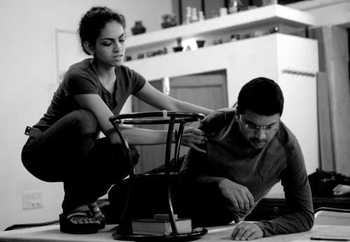For years, science and arts have been two completely different domains of study; there never being any kind of confluence between them. But what happens when the ‘intelligence’ of science and the ‘creativity’ of arts come together on stage? That is just what Bangalore city has been witnessing over the past few days.
Professor Alan Brody of Massachusetts Institute of Technology, award winning playwright and Professor of Theatre and Arts has brought with him a completely novel concept of ‘Science Theatre’ to enthral and entice the curiosity of students and the general masses alike. This is an interdisciplinary method of trying to bring science and scientific ideas to life on stage, making it easy to understand not only for students but also to enlighten the general masses. A unique way indeed to spread the realms of the scientific world far and wide!

Professor Alan Brody of Massachusetts Institute of Technology. Pic credit: Bangalore Little Theatre.
With this motive in mind, The Indian Institute of Astrophysics Bangalore recently organised a talk on – Enriching Science Education: The Role of Science Theatre by Professor Brody. This intermediate field aims to make science and scientific concepts like Theory of Relativity and Heisenberg’s Uncertainty Principle well known to the general public, easy to understand and interesting for students. Not just that.
In Professor Brody’s words, “Science Theatre reflects the transitions in society. Science as such is generally involved with the pursuit of truth and the job of theatre is to embody some aspect of the truth as it is. Theatre can be a major tool in public engagement of science.”
Although this concept is relatively new, it already seems to be in full swing at the Massachusetts Institute of Technology, where as Professor Brody says, "The aim is to make students understand scientific concepts and principles and then embody it in a scientific production.” Every year, a series of four to five scientific plays are shown at MIT, in collaboration with theatrical institutes in Cambridge and these draw large audiences, he says.
While there are different types of ‘Science Theatre’ such as those depicting scientific issues, theatre lovers in Bangalore got a glimpse of Biographical Science Theatre recently with the play Small Infinities written by Professor Brody and directed by Prakash Belawadi at the MLR Convention Centre, Brigade Millennium.

The play ‘Small Infinities’ enacted by the Bangalore Little Theatre artistes, portrayed the major breakthroughs and changes in Sir Isaac Newton’s life. Pic credit: Bangalore Little Theatre.
The production, a creative partnership between Bangalore Little Theatre and Brigade Hospitality portrays the life of Sir Isaac Newton. The play enacted by the Bangalore Little Theatre artistes, portrayed the major breakthroughs and changes in his life and the emotions it created. It outlines Netwon’s fascination in alchemy which he practiced in secret and his desire to use science, alchemy and the Bible to discover God’s design. Even though Netwon was one of the finest scientists of the modern age, it shows his inclination to do what he believed was God’s will. Maybe, that’s why as Professor Brody says, “the life of a scientist is always interesting to a playwright.”
The brilliant performances by the actors, captivated the imagination and attention of the audience completely.
Madhulika Chakravarty and Kshitij Hastu, both students of Brigade school said, “The play was brilliant and extremely interesting. It helped you understand the different complexities that these scientists went through in their lives and portrayed the eccentric genius that Netwon was. All of us liked it very much.”
This production is the fourth in the series of biographical plays under ‘The History of Ideas Programme’. This is an ongoing programme producing plays and other dramatic material on the lives of great scientists. This Programme has already produced three full length plays and several staged readings in Bangalore.
‘Science Theatre’ has a promising future, going by the enthusiastic responses. These kinds of plays are sure to make the knowledge of the vast world of science exit the esteemed portals of the ‘intelligent few’ and reach the common man. ⊕